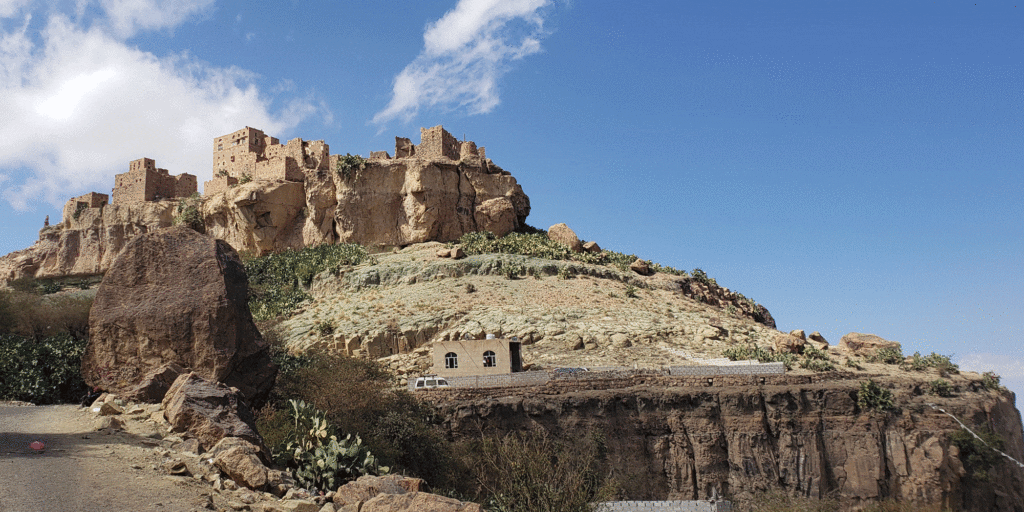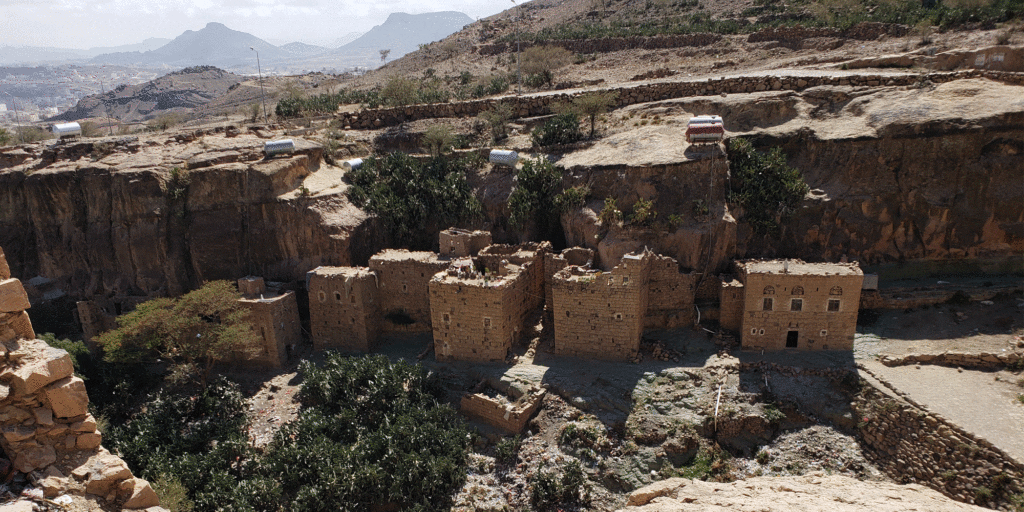“We’re seven individuals, and we only have three duvets which are not enough for us and never protect us from cold.”
I was thinking about the moments when the seven-year-old village boy uttered these words, narrating his seemingly endless story of suffering. How should his life have been? What should have been his biggest concerns if he had been in any country in the world other than Yemen? He raised his arms, interrupting my train of thought, and said: “The night there is freezing, the wind is always howling and mom is lying in one of the unequipped rooms. Mom needs an emergency eye surgery. My father and I sell ‘prickly pears’ to collect the money required for it.

Abandoned Houses
The young boy was speaking of a house in which he has taken refuge with his family, after it was abandoned by its original inhabitants because it currently no longer meets living standards, and most, if not all, services do not reach it due to the difficult road leading to the village it is in. This house and others on the first corner of the Bayt Baws village shelter homeless families, who had to restore some basic elements of the houses that were still relatively viable for living, while dozens of other buildings and houses were completely destroyed. These families had no other choice but to accept the houses’ conditions as they were, in order to avoid being thrown on the sidewalk during this time of war.
Many Yemenis have left their homes or have been forcibly displaced and have become homeless, in various regions. By the end of 2019, the number of internally displaced persons reached around 4 million, according to The United Nations High Commissioner for Refugees.
This village’s history has always been associated with Jewish people, as references say it had belonged to them but they were living side by side with the Muslims. The village was named after their ancestor, Dhu-Baws ibn-Sahar ibn-Shurahbeel, and it is also said that it was named after a Jewish man called “Baws”, who was the first to live and build there. Its original inhabitants abandoned it after its only source of water began to dry, which had been a large dam that held rain and was called ‘Kamran Dam’. The situation remained this way even until the era of Imam Al-Hadi, who proposed to the Jewish people to sell their lands with deeds―or sukuk which is the Arabic name for financial certificates―in return for moving them to larger gatherings in Sa’dah, Raydah and Bajil districts, after the significant decrease in their number, as a result of their external migrations to Palestine. Imam Al-Hadi thought of gathering them so they would be able to pray, celebrate their feasts and perform Shabbat traditions; so the Jews of ‘Bayt Baws’ agreed to leave the region and did in fact move to Sa’dah.


A Castle for the Homeless
Bayt Baws’ castle is one piece of evidence relaying the succession of the ancient historical civilizations of Yemen; It’s a village in the southwest of the capital Sana’a, built in the 18th century BC. It extends over a mountainous area of about half a kilometer, and consists of around 200 houses built of red bricks of several layers, built on top of a mountain using the stones of the mountain itself. This also provides proof of the architectural excellence of the first Yemenis, who used to sculpt houses on the highest mountains―to be used as “fortification”―and leave the valleys for agriculture and grazing. Whoever takes a look at this village imagines a brilliantly constructed divine arch, as there is no access to it from the north, east or west, except for a single outlet for it in the south, where there had been a wooden gate that disappeared years ago, according to one of the villagers. Throughout the civilizations, it was ideal for use as a shelter for those hiding from enemies outside, as well as for use as a detention center for important or very dangerous figures.
The village now shelters some 33 families from various provinces affected by the conflict that has been going on in Yemen for five years.


Grave danger
The village is distinguished, despite its ancient attributes, for a remarkable civil design and modern division of affairs of life; niche markets are located along the outskirts of the village, reflecting the renaissance and development that the Yemini civilization enjoyed in the past. These markets were destroyed a year ago, after they’d withstood for centuries against the ignorance of the responsible authorities that allowed erosion factors to dismantle and take advantage of them, before the hidden mysteries of history were discovered behind the winding stones of the village.
War struck and threatened the region once more after these families had revived the village, and air strikes by the Arab alliance targeted the area. They justified this crime by the presence of a camp near the village, an act that is considered a violation of the convention ratified by the General Conference of the United Nations held in Paris in 1972, which states in article 6, par. 3 that “Each State Party to this Convention undertakes to not take any deliberate measures which might damage directly or indirectly the cultural and natural heritage situated on the territory of other States Parties to this Convention.”
According to the first paragraph in Article 4 of the Hague Convention on Protecting Cultural Property in the Event of Armed Conflict, “the High Contracting Parties undertake to respect cultural property situated within their own territory as well as within the territory of other High Contracting Parties by refraining from any use of the property, and its immediate surroundings or of the appliances in use for its protection for purposes which are likely to expose it to destruction or damage in the event of armed conflict; and by refraining from any act of hostility, directed against such property.”
“There was a treasure buried here discovered by the German ambassador’s super dog,” says one of the young men from this village who came from Al-Haymah District after the war intensified in his area and livelihoods were cut off. “Nearly 20 years ago, the German ambassador and his entourage came on an exploratory trip to the place with a trained dog, with whom he uncovered the presence of treasure in the wall of this house. When they dug, they found jewelry that was buried here long ago.” This exploration was not under the control of the Yemeni government, according to what this young man who had heard the story of the treasure upon his arrival in the region tells us.


Destruction
“Two years ago, I was sitting here listening to some local music on the radio, and suddenly the market was destroyed,” says a displaced young man describing the crash of the village market, which had been designed along the village’s length, and whose shops were divided according to the services they provide. The village owners used to gather on the Wednesdays of each week to buy and sell in a small festival of sorts that has been occurring since the establishment of the village.
The state has not paid attention to the region since the era of the Tahirid dynasty, and the village has become forgotten and excluded from study and excavation, despite the ambiguity and myths that are hatched around the region, most notably studies conducted by a number of people including the researcher Fadel Al-Rubaie (of Iraqi origin), who had, according to him, provided new literature to correct history. His books formed a broader link and deeper analysis of the relationship of the Jewish religion and its history in the Arabian Peninsula in general, and Yemen in particular, relying in his research on the Torah written in the Hebrew language and comparing between the text, historical events and the Arabic-Hebrew semantics, as well as Al-Hamadni books “Al-Iklil wa Sifat Jazirah Al-Arab” (Characteristics of Arabian Peninsula) and other historical references.In his book, “Quds is not Jerusalem”, he proposed the idea that Quds and Jerusalem are not the same, but rather the Jerusalem mentioned in the Torah to which the exiles returned to and had started construction work on its destroyed walls actually refers to Bayt-Baws in Yamin. The great irony is evident when we look at the list of the names of the tribes and the groups that participated in building the city. They are Arab Yemeni tribes that believe in Judaism, and whose traces are still there.
The tales of Bayt Baws and its history and rich heritage are now threatened with extinction, but no one cares.


.





